Patrick Huston looks at the factors you’ll need to consider before investing in new archery equipment, from selecting your limb materials to knowing which tab shape is right for you
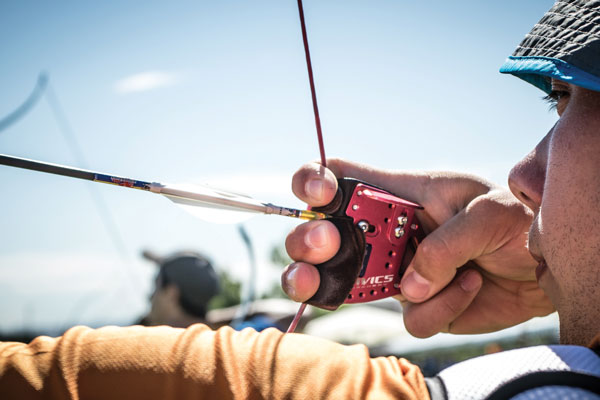
Tabs come in loads of shapes, weights and sizes, but the most important factor is the anchor point you can achieve with it
There is a lot of choice when it comes to buying your archery equipment. We can shoot a Hoyt riser with MK limbs, a Shibuya sight, Doinker rods, a Beiter button, Carbon Express arrows and spin wings. Or we might go with a full W&W bow with an Axcel sight, a Shibuya button and Spigarelli rest, Mybo Certo rods and Easton ACEs… the choices keep on going! But how should you be deciding what to shoot? Let me help you a little bit with some of the knowledge I’ve gained over the years for some of the various pieces of equipment you’re likely to run into when perusing an archery shop, whether online or in person.
This will be particularly useful if you do most of your shopping online, as many do. In this article I’m just going to cover the most important elements: riser, limbs, arrows and tab, and a couple of strategies for buying them. My next article will contain more detail on the wondrous world of archery widgets.
Riser
Stiff bit in the middle: let’s start off with the riser as it is most central. First off, the main choices are aluminium or carbon. Aluminium has been used to manufacture risers for decades – it is a very known quantity and has 100 per cent proven results. Carbon is a newer material with which companies have started to craft recurve risers.
Carbon offers many more options in terms of construction with layer weaving, inclusion of metal elements and hollow versus solid construction building techniques available.
Aluminium tends to give a slightly more solid and settled feeling in your shot, while carbon risers are more jumpy and snappy. This can result in more consistent groups with aluminium, but greater accuracy (and larger fliers) with carbon. Carbon bows also benefit from quick shooting, so if you are a long holder then you will be a little at the detriment of a carbon bow.
I may say this a few times going through this article, but to really get an understanding of the difference in feeling for a carbon versus aluminium riser you need to shoot them side by side with similar set ups.
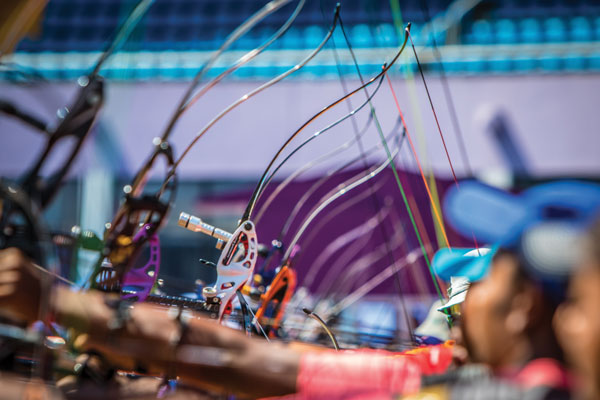
Whichever tab design helps you achieve this while having a relaxed and stretched out feeling is the tab for you
Limbs
Bendy bits at the end: next up we have the limbs to choose. We have a few elements to think about here, but poundage is the first and foremost thing which needs to be considered. All the rest just fine-tunes their suitability for the archer, but if you get the wrong poundage to shoot then you will shoot bad scores, get upset and likely even injure yourself.
You need to select a poundage which you are totally able to control over 150 arrows for a tournament where you can shoot the last arrow as well as the first one. This may very well mean a much lower poundage than you are able to comfortably draw. Remember, it is about control over a long period of time, not speed or power! If you want to work up to higher poundage limbs try adding a little bit of elastic around your string for a few ends every day for a week or two, steadily increasing the number shot with it.
There is much discussion over whether an archer should shoot wooden or foam limbs, but it doesn’t make as big a difference as people think! Foam will tend to be a bit more powerful and put more speed down range, though this comes at the expense of a ‘stacking’ poundage coming through the clicker. Wood tends to be a little slower in terms of arrow speed, but more stable and less twitchy at full draw and smoother to expand through. There is quite a bit of talk that the new Bamboo Core X-Tours from Hoyt are actually faster than their wood!
Another question is, to Formula or not to Formula? There is a reasonable decision to be made in terms of whether to shoot Formula limb fit or International Limb Fit (formerly known as Hoyt fit). If you haven’t come across this difference yet, basically Hoyt decided to make their flagship risers and limbs matched, and hence different to the limb-to-riser fitting system used by other companies, in about 2010.
The difference is in the length between the dovetail and pivot point, which is longer in Formula limbs. A lot of marketing waffle says this is more stable, but World Championships and Olympics have been won with both Formula and ILF, so they both work. Do bear in mind, however, that there are fewer second hand and intermediate Formula limbs for sale. That said, having been on the market for a good few years now MK and Uukha both make Formula limbs, with MK even making a bow which can very easily take either ILF or formula. Personally, I shoot Formula… if that makes any difference.
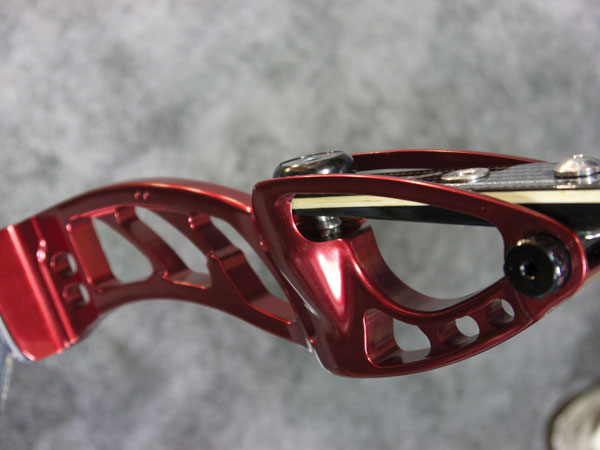
Hoyt’s Formula limb fit is longer between the dovetail and pivot point, meaning there are fewer interchangeable options than with an ILF system
Tab
The archer has only two interfaces with the bow, the front hand grip and the string fingers. It is therefore absolutely crucial to get the right tab to shoot with. What you need to be looking for in a tab is one that allows your hand to stretch out and be relaxed at full draw, while giving your fingers an adequate and stable grip on the string. But how do we construct this?
Most tabs are cordovan leather which is red and slightly fluffy on the inside and smooth on the front, but something most people don’t realise is that you can experiment with a huge variety of backings and even faces for your tab – JC Valladont uses the insole of a base model Decathlon trainer!
What we really need to make a decision on is the spacer design, weight of the tab, and the back plate. Spacers can be rounded, flat, molded or soft. The key goal here is that you get one that keeps your fingers evenly separated at full draw and clear from contact with the nock. If your fingers are touching, try building up the spacer between your knuckles, not the fingers.
The weight of the tab is quite personal, though since the release of the KSL Gold tab many people have been moving towards a heavier tab. The thought here is that the increased mass weight slows the movement of the fingers and therefore bad releases will be criticised less. I’ll admit they feel really cool to shoot.
The shape of the plate can vary hugely. From the Angel tab – which is scarcely more than a piece of leather with some pieces held onto it – to the bronze KSL with palm plate and a huge spacer, there’s the black Mamba, Simon Fairweather (kangaroo leather and rubberised fitted ring) and even the Fivics Spoon (that’s not its official name, but is what it looks like). These are very different, and are all going to affect how the palm and fingers interact on the shot, so some are going to work much better for you than others depending on your hand size and shape, and your hook. Really, you just need to try them. Try asking around and see what you can borrow for a few shots.
To take it at its simplest, you want as much contact between your hand – fingers, thumb, wrist and so on – and your jawline, neck and neck tendon as you can. Whichever tab design helps you achieve this while having a relaxed and stretched out feeling is the tab for you!
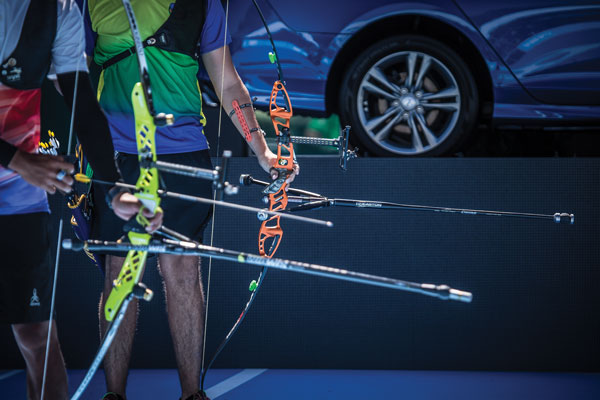
If you have a look at between 50 and 100 archers the chance of you seeing the piece of equipment you are interested in is quite high
Arrows
Selecting the right arrows to match your bow is absolutely crucial to shooting high scores! However, please be pragmatic in appreciating where you are on your archery journey before you spend loads of money on arrows – I’ll lay out some of my thoughts on this in the next article, but the key point is to not spend money too early.
The arrow spine is something totally dependent on your bow’s draw weight, your arrow length, technique, and various other smaller factors. This means that you can very easily select, and spend a lot of money on, the wrong arrows.
Arrow manufacturers all have an arrow spine chart that allows you to accurately select your spine from your poundage and arrow length. This doesn’t need you to get your bow weighed, as I know some archers won’t have a set of bow scales or access to a coach or club that does.
Let me give you a hint – luggage scales. Even a 58lb compound is under 25kg, which luggage scales comfortably read for international flight. Do be careful not to let go, or buy a set with flimsy catches and so on, but trust me, they work. Make sure to pull all the way through your clicker and do the final bit slowly, with someone watching to read the scales accurately. Then take this, and a measuring tape accurate measurement of your arrow length, to the Carbon Express or Easton arrow chart to find the right spine. Both can be found under the ‘resources’ tab on my website PatrickHuston.com along with past articles.
But what sort of arrow should you go for? This very much depends what type of archery you want to specialise in. If you’re only going to shoot indoors you may as well buy big fat arrows, but if you are planning on doing a lot of field let’s go light and fast. Outdoor target focused archers are likely to want a bit more weight and less diameter, and these arrows can adapt over to other styles as well. There is a lot of detail to realistically talk about here so see my next article for the specifics of arrow selection!
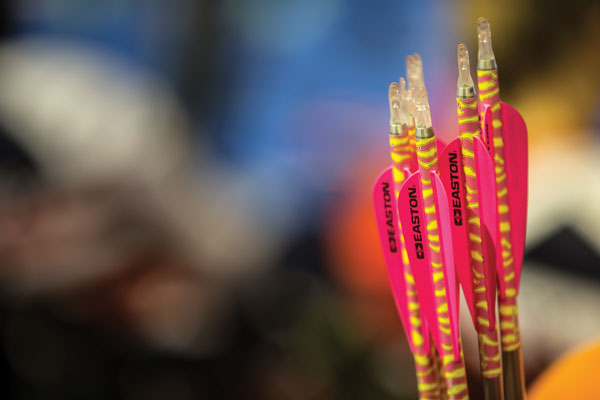
Selecting the right arrows to match your bow is absolutely crucial to shooting high scores!
How to buy
Archery equipment can be expensive. If you buy everything top of the range and new you could easily be looking at £2,000-£3,000, which you don’t really need to spend. Feel free to spend it if that’s the kit you want and you’ve got the money, but if you go about this in a savvy way it’s not too hard to be able to give most things a respectable test to see if they suit you before spending your hard-earned cash.
First off, visit a few of the clubs in your area. If you have a look at between 50 and 100 archers the chance of you seeing the piece of equipment you are interested in is quite high. We really are quite friendly creatures and if someone compliments us on our choices of equipment I’d say you have a good chance of being able to borrow it for a few ends. That may be all you need.
Take a weekend off tournament chasing and go and physically visit an archery shop. Make sure they have the equipment you are interested in in stock (many can order on sale or return from the distributors). Ask archers in your club for recommendations of the best shops to visit, and ring up before going to make sure they have the gear available you’re interested in buying.
I can really recommend that you join some archery for sale Facebook groups. If you’re on a budget these can be a great way of grabbing second hand kit at very reasonable prices.
Look out for part two where I’ll talk about arrows in detail, the stabiliser choices to be made, as well as sights and sight pins. Shoot well!
This article originally appeared in the issue 119 of Bow International magazine. For more great content like this, subscribe today at our secure online store: www.myfavouritemagazines.co.uk

